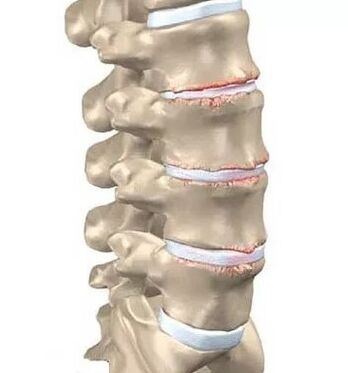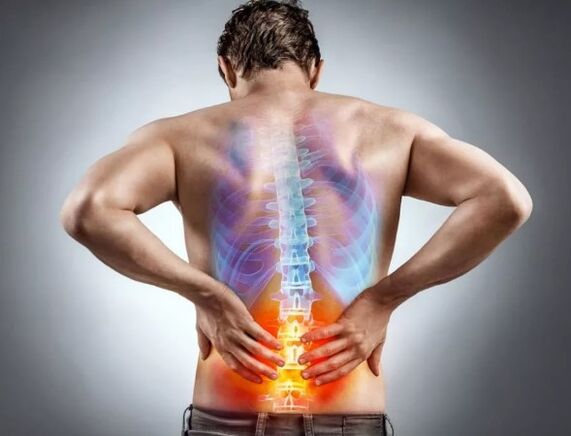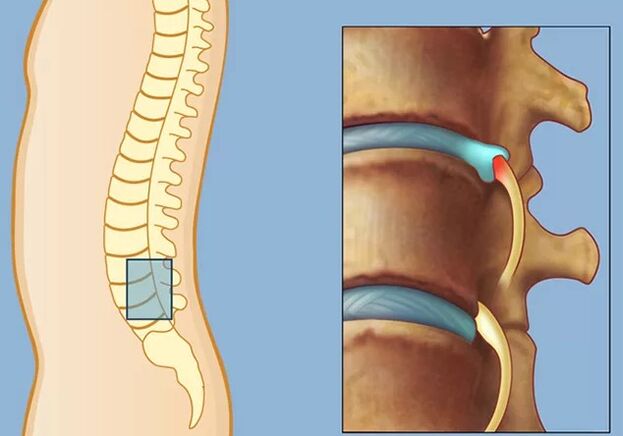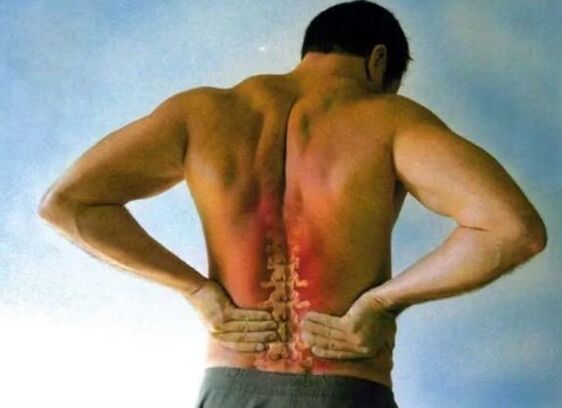Lomber is an osteocondrosis of the spine, a disease with a particular form of spine. Patients with such a disease complain that limiting speed fatigue, back pain, legs and motor activities. With osteocondrosis, there is a deformation of intervertebral disks, their height, distract and corakoid spines have growing. When diagnosed in radiography, the discharges are clearly visible.

During the development of acute tissues, it is a complex process, including deformation, biochemical and vascular changes. First of all, ribbon rings are destroyed as a result of applying pulpose. As a result, the fiber ring was torn and the disk came into hernia. In this case, the low bright and low-loving segment is exposed to the highest load. The spinal cord or the rump of the disk is the cause of the back pain that responds to the leg.
The most powerful sciatic nerve in the human body is formed by the sacred roots of the spinal cord. It is also irritated with both the bottom in love, but also osteocondrosis. In this regard, the second name of the disease occurred in connection with this work - Isias.
Due to the violation of the cartilage fabric structure, the intervertebral disks with special cartilage structures can no longer fulfill all functions. This causes the elasticity and mobility of the spine. In the early stages of the disease, the processes that only affect intervertebral disks are gradually applied to the spines.
It is almost every fifth person in a discogenic radicolite world, one of the most common symptoms of osteocondrosis. At risk, people who are working age are at most risk. Osteochondrosis violates the ability to engage in active activity and often causes disability.
The main symptoms of Lomber Osteocondrosis are severe back pain. But in addition to this sign, there are a number of others. Thus, patients suffering from this disease are quickly tired, they complain about headaches, fatigue and irritation. The discomfort in the back does not allow you to choose a comfortable position for sleep, so the body can not be fully relax and restore after the end of the day. The loss of power is to minimize the patient's physical activity and avoid pain. This is due to the fact that it is not able to perform simple actions in order to meet its own household needs.

Problems in the work of the Genitouria system can also be one of the symptoms of the pawnshop osteocondrosis. They appear in the form of pain in the kidney area. In patients with osteocondrosis, the urine is violated, the unexpected event of the incident is possible. This causes unsteadiness of spines that are not identified by intervertebral disks due to deformation. The load of the spine is a department of the department of the department, which is the weight of the power. Such a process causes internal organs to harm problems in their work. In women, ovaries, supplements and uterers suffer the most and are worried in potential men.
Osteochondrosis is characterized by an increase in sensitivity of feet, including standing, hips and lower legs. Are cramps that can cause the full loss of pulse. The patient's skin in the legs is very dry, peeled and covered with goosebumps in the field of concern. Sweating is broken during the butu of pain.
All the symptoms of osteocondrosis can be classified into the following groups:
The subtle for intervertebral disks causes the loss of stability vertebrae. With mobile, they begin to annoy and squeeze blood vessels and nerve roots with sharp movements and heavy movements. This process minimizes the pain in the waist, but continues with the updated vitality where the nerve is compressed. The pain is sharp and drilling. Most worries are expressed in the lower leg, thigh, foot and hip. Unpleasant feelings make the patient change the gait, based on the opposite side of the nervousness.
When nervous roots are irritated for a long time, inflammation, swelling, venous stagnation and intoxication occur. The pain belongs to the muscles and ligaments. Especially after a lack of sleep or relaxation, it is the most acute in the moments of physical activity without those who are not hot immediately. The pain is often accompanied by vibrating sweating, which replaces the feeling of coldness.
The manifestations of the radical syndrome include the loss of tingles, numbness and sensitivity. The muscles lose their tones, so patients are not able to stand physical activity for a long time, for example, remove the stairs, quickly tired. The functions of the pelvis are particularly violated in difficult works. In this case, it is possible to form paralyzes and paraphets.
It is a blood vessels compressed during deformation near the nerve roots. In the first stages of the development of osteocondrosis, the veins are periodically compressed, but then a spasm is a constant character. In this case, the "Punk into a concern" occurs, the patient should often walk and relax long.
The blood vessels that connect, causing the necessary nutrients of the pelvis organs. This causes pain in the pain in the hips, perineum, until their paralysis.
Vertebrate syndrome
Under the influence of pain, ischemic and radical syndrome, the patient deformed the skeleton with osteocondrosis. A person begins to bend, a pelvis and waist, muscles weaken, atrophy. All these changes affect the ground that is adjustable, intense and uncertain depending on the field of pain. Gradually, the entire muskuloskeletal system is exposed to osteocondrosis and intervertebral disks continue to collapse.
Unpleasant feelings and concerns in the back are basic symptoms for osteocondrosis. The nature and power of the pain varies depending on the stage of development of the disease.
Initially, only when playing a physical exertion, it is only felt in the Lomber region during the increase in the tension of joints, muscles and ligaments. Can also be a continuous pain. However, with acute pain or sliding, even sneezing, coughs occur with the development of osteocondrosis.
Palpation, as a rule, allows you to set the seal in the muscles. The pain attack may last a few days, and this time the patient should observe the patient bed rest to minimize unpleasant feelings on the back. Any sharp movement, raises weight loss.
The following main reasons for the development of Lomber Osteocondrosis are different:
- Uneven load in the spine. According to experts, as a biological type of osteocondrosis, as a biological type, because it is related to life and directing. The need to protect the body's position in a certain situation requires constant tension of the musaloshelet system. The optimal load of the spine will be in a permanent position. In the back of the back, it is minimal, on the side - a little more. However, in a sitting, the load on the waist increases significantly. The bending of the body creates an extra tension for the front edge of the spine and the front edge of the spinal column. Therefore, it is recommended to change the body's position from time to time, change the rest and load on the back of the muscles and catch the back.
- Hypodynamia. A sedentary lifestyle, using a car and public transport, consuming a lot of time for computer and television, all this helps to develop problems with spine, including osteocondrosis. An important part of the population should not be in motor activities. A passive lifestyle shows that the musalosheletal system has weakened. In the seat position, the spine is exposed to maximum load, this is the reason for the deformation of the cartilage tissue, and as a result, the cause of osteocondrosis of the waist region. Therefore, it is very important to get up from time to time and make a number of training. When a person spends a significant part of the time, the bend muscles stretch and lose their tones.
- Very high physical activity. As an increased motor activity, disadvantage, osteocondrosis can also occur. Back pain is often worried about athletes engaged in weightlifting. This sport requires weight lifting that provokes additional voltage for rear muscles and provokes the formation of intervertebral torns.
- Wrong posture. In the curve position of the spine, this burden is unequally distributed, and it causes intervertebral disks. Affected as a result of the fact that the same effect is not properly. People and older people fall into the risk group, because when the time passes, intervertebral disks are less elastic, lose their mobility and are easier to damage.
- Flaws of the bone system and genetic tendency, injuries and infectious diseases. As a rule, osteocondrosis creates a congenital problem in the musaloshelet system. In addition, the cause of the disease may be the natural fragility of the cartilage. Osteochondrosis, at the same time, is developed as a complication after various losses from tuberculosis, Osteomyelitis.
- Straight legs. In patients suffering from flat feet, the set of the foot does not perform depreciation functions, as in normal condition. Thus, when moving, all load is carried on intervertebral disks, resulting in their fast wear.
- Overweight. The extra kilogram is heartfelt and the bone muscle system, thus an additional load source on the waist. According to statistics, people overweight are more sensitive to various diseases.
- Inflammatory processes in the body. The development of osteocondrosis, hormonal changes, waist combinations, such as rheumatoid arthritis, an impaired endocrine, such as factors such as digestion and cardiovascular system.
- Life. Many patients do not pay attention to: They move less, do not sleep enough, they eat wrong. This causes increased fatigue, psycho -emonal condition to disrupt the situation and stress. All this makes the body very sensitive and contributes to the development of waist osteocondrosis.

Lombber has 4 degrees osteocondrosis:
- Cracks appear inside the fibrous ring, which is filled with an item of Jet Nucleus, which causes irritation. At this stage, the deformation of intervertebral disks expresss poorly and reflects itself in the form of reflex-boolery symptoms. The patient can complain about the pain in the heart, the lower back. Behind the reason of anxiety, sharp movements, the weight lifting. Depending on the character, 2 types of pain are different: Lumbalia and Lumbago. In the first case, it is stable and occurs at the second;
- Fibrus continues to destroy the ring. However, there is a decrease in the space between the spines, nerve endings are squeezed. At this stage, a phenomenon is characteristic of the Lumbar region as pseudospondylaticistanz. This is the name of the displacement process relative to each other relative to each other, which pinch and pain causes the nervous ends. Spine is characterized by unusual mobility. With grade 2 degree osteocondrosis, patients are felt in the background, heat and cold in the spine. Pain shows itself in the skin by the seizures that are defective and intensification of intensification;
- Fibrous Ring has finally torn and the jacket core is squeezed outside. The intertevrevral hernia appears. To squeeze its core in the area of the spinal canal, leads to ships and roots of spinal nerves.
The spinal deformation is formed by Lordoz, Kymphosis or scoliosis. The spine is turned forward with lordosis. Such a violation of the normal position makes the work of internal organs and their systems very difficult. With whom, the upper spine is curved and in advanced cases. The lateral curvature is manifested in the form of scoliosis. A patient suffering from such a curve of the spine is noticeable thanks to the knife or ribs that have a disease suffering from osteocondrosis;
- The final stage of osteocondrosis is the most dangerous, because the spine is finally deformed, which makes it impossible to fully motorized motor activities. Bone growth is noticeable in radiographs. Though the pain does not disturb the patient for a while, this does not show an improvement. 4 degree osteocondrosis ends with the most disabled.






































